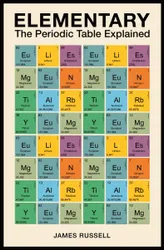(N.B. This review is for the first edition. A second edition was published in 2021, although it’s not clear if this is just the paperback edition or if any other changes were made!)
This book is a run-down of all the elements in the periodic table. The section for each element begins with a table of basic information, like melting and boiling point. The text then describes how that element was discovered and isolated, and who by. It also describes some of the element’s properties and how it’s used. And that’s about it. It just goes through the elements in order of atomic number with a couple of pages on each one. It’s a bit like a mini encyclopedia just focused on the elements.
I learned some interesting facts about how elements were discovered. It seemed like the discoverers were often just doing random experiments until they found something that worked in order to isolate an element from some mineral. I enjoyed learning about the various uses we have for different elements, either on their own, in compounds with other elements, or in alloys (for the metallic elements).
I was surprised to learn that elements that were artificially created were not included in the periodic table initally. I was also surprised by some of the groupings. When we studied the periodic table at school, I remembered the groups as vertical columns of elements in the table, containing elements with similar properties. But in this book I learned that there are other types of groups. Semiconductors, for example, form a sort of group diagonally across the table.
The writing style is clear and easy to read, and the book is well-organised. But since it’s just a list of elements in order, you could argue that the book is actually less well organised than the periodic table itself. The explanatory structure of the table is lost when you just list the elements in order of atomic number. I wonder whether the author considered going down the groups rather than across, in order to keep elements with similar properties together. I did have to keep referring back to the periodic table, helpfully printed inside the front and rear covers of the book, to remind myself where we were as it’s easy to lose track otherwise. I suppose this underlines how useful the periodic table is and why we structure it the way we do, rather than just having a list of elements.
I came at this book with a bit more knowledge about electron shells from studying chemistry at A-level and physics at university, and I would have liked a bit more information about why the configuration of electrons is significant for the chemical bonds an element can form. This would have helped explain why the periodic table is the way it is, how atoms bond with other atoms to form compounds etc. The introduction tries to cram a lot in, but could leave some readers behind. Some basic information on atomic theory would go a long way, including a diagram of the atom at the level of protons, neutrons and electrons.
For the heavier, unstable elements, I would have liked to see half-life included in the information next to the name. I also noticed a possible mistake in the section on Uranium. It says that “Uranium is the only naturally occurring element that can be used in nuclear reactors” but the section on Thorium contradicts this.
Elementary is an interesting read, but quite basic and light. As a jumping off point for further study, particularly on the scientists who discovered the elements or the methods they used, it could be quite useful. But it’s hard to see who would really get a lot out of this book. The information feels quite superficial. If you have some science education, you’re going to find it rather simplistic and unsatisfying. If you don’t have much science education, it doesn’t do a particularly good job of explaining the science behind the periodic table; you could end up thinking that science is just a list of facts to memorise about the elements when there is a beautiful and logical explanation for why the periodic table is the way it is, and the predictive power it gives us. I think this book is a bit of a missed opportunity.
